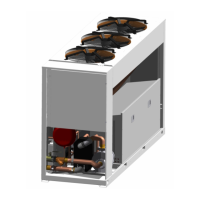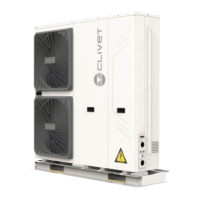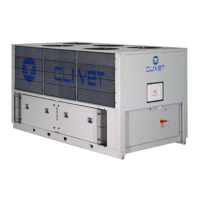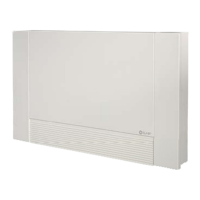53
®
GENERAL
The aim of the following sections is to provide possible solutions to a number of anomalies that may arise on the unit. The information
provided does not cover the entire range of possible cases. The activation of a safety device indicates abnormal operation; before
resetting it, check and eliminate the causes. The following is a list of possible problems and the corresponding causes and solutions.
CAUTION
These operations must be carried out by specialist technical personnel possessing the legal requirements and in compliance with the
safety standards in force.
Before performing any checks on moving or live parts, switch the unit off at the mains isolator switch.
ANTIFREEZE ALARM
LOW PRESSURE ALARM
FLOW ALARM
HIGH PRESSURE ALARM
COMPRESSOR THERMAL OVERLOAD ALARM
THE UNIT DOES NOT START
FAN THERMAL OVERLOAD ALARM
1. Check that the circulation of water is correct (circulating pumps on, valves open, water filter system not clogged, ...).
2. Check that there is no air in the system and if necessary vent the air using the manual valves (if present) or alternatively check the
correct operation of the automatic vents.
3. Check the wiring of the safety devices.
4. If the alarm persists, contact an Authorised Service Centre.
1. Check that the coils are free of obstacles, such as cardboard, nylon, leaves or dirt, and that the functional clearances described in
the "Receipt-positioning" section are respected.
2. Check that the fan is working and that the direction of rotation is correct.
3. Check that the air and water temperatures are within the limits described in the technical data in the "General" section.
4. Check that the high pressure safety device is working correctly and check the related wiring.
5. If the alarm persists, contact an Authorised Service Centre.
1. Check that the unit is operating within the envisaged temperature limits (water, air).
2. Check that the refrigerant circuit is pressurised and there are no refrigerant leaks.
3. Check that the low pressure safety device is working correctly and check the corresponding wiring.
4. If the alarm persists, contact an Authorised Service Centre.
1. Check that the antifreeze set point value is not too high.
2. Check that the control set point value is not too low.
3. Check that the circulation of water is correct (circulating pumps on, valves open, water filter system not clogged, ...).
4. If the alarm persists, contact an Authorised Service Centre.
1. Check the wiring.
2. If the alarm persists, contact an Authorised Service Centre.
1. Check if any alarms are shown on the display: if alarms are active, check the type of alarm in the "Control" section, and act based
on the information provided in the "Troubleshooting" section (if present), or alternatively contact an Authorised Service Centre.
2. Check that the unit is powered: check the isolator switches and circuit breakers upstream of the unit
3. Check that the display on the unit's control panel is on
4. Check that the ON/OFF button is ON
5. Check any external enabling signals (timer, flow switch, remote ON/OFF, ...)
6. If present, check that the compressor switches on the control panel are ON
7. For summer operation, check that the set point temperature is lower than the inlet temperature; for winter operation, check that the
set point temperature is higher than the inlet temperature.
1. Check the wiring.
2. Check that the fan is free to move, without obstacles or obstructions (jammed bearings, ...).
3. If the alarm persists, contact an Authorised Service Centre.
- TROUBLESHOOTING -
Troubleshooting

